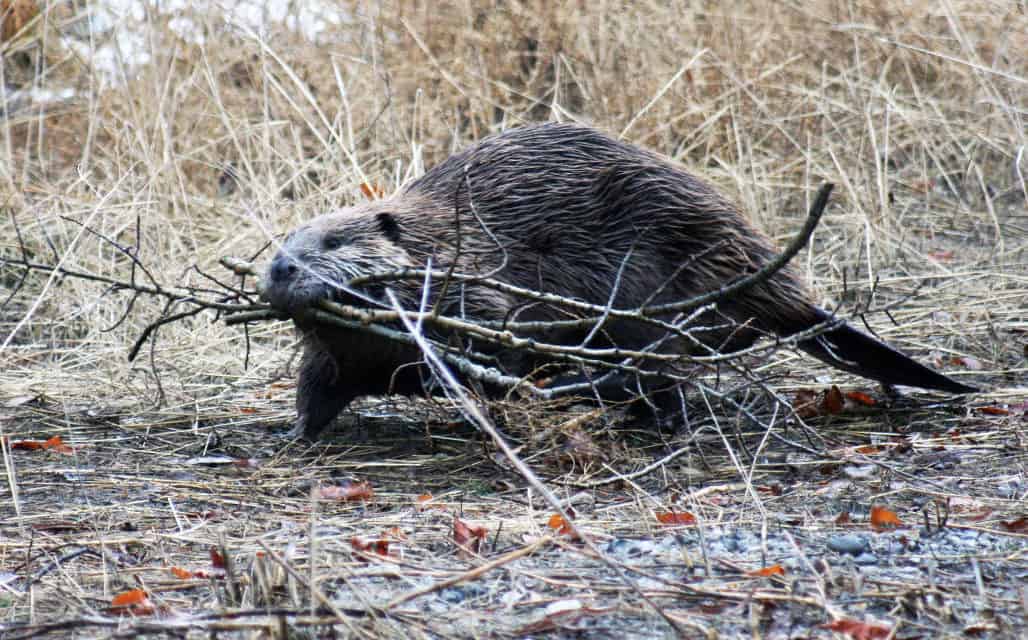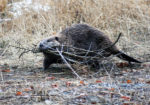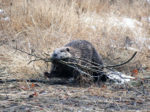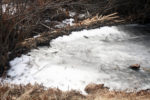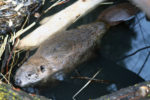Story and photos by Stacy Fisher
Any stream, creek or tributary in the Sierra-Nevada is potential beaver country.
Robbers Creek in Lassen County is fed by three springs, starting at about 5,325 feet elevation. The creek meanders its way for several miles, flowing through the town of Westwood before empting into Walker Lake.
The creek is home to a number of industrious North American beavers that spend their nights carefully crafting dams of mud and branches to create a deep pond where they build well-insulated lodges to raise their kits, or baby beavers. Their work makes beavers a keystone species in maintaining habitats.
The cold doesn’t phase beavers, and they remain active throughout winter even when their ponds are covered with a layer of ice and snow.
One neighbor who has lived near the creek’s bank for 34 years has noticed the beavers building their dams for decades.
“I enjoy watching the beavers walking around,” she says. “But you don’t see them very often,” because they’re often in the water and are nocturnal creatures. “To see them out during the day on land is rare. Usually, if you’re lucky, you can catch a glimpse of them just after sunrise or before sunset.”
She had a grove of tall aspens growing in her backyard near the bank, “but over the years they’ve taken them all.”
Although beavers are not aggressive creatures, if they feel threatened, they can use their sharp teeth and powerful jaws to cause injury. Their broad tails can also smack ankles and shins with serious force.
Her dogs know to stay away from the beavers, she remarks. “They’ve learned that if they get too close, the beaver will slap his tail against the water to warn them to stay away.” She recalls that someone told her once that intimidated beavers can pull a dog underwater and drown it if the dog wanders too close to the entrance of their lodge.
Beavers are very good swimmers and can hold their breath underwater for up to 15 minutes. A set of transparent eyelids enables them to see clearly while submerged.
“One thing that happened some years ago was a beaver falling a large tree near my garage. It landed on the corner of the roof and damaged it.” She also had a tree fall on top of some power lines and cause sparking.
Despite the occasional minor damage to her property, she says she’s fine with it. “This is an area where the beavers live.”
Beavers are among the largest rodents on earth. A typical animal can weigh between 30 to 70 pounds depending on gender, and grow up to three feet long as an adult. The female is larger than the male of the same age, and typically gives birth to two or three kits sometime between early spring and fall.
Beavers have poor sight but a strong sense of smell and good hearing. As herbivores, they’ll happily feed on trees and tree bark. Common favorites include cherry, alder, maple, birch and aspens. They’ll also eat water lilies, small twigs, pondweed and leaves.
Predators like bears, wolves, wolverines, lynx, coyotes, otters, and eagles like to eat young beavers for dinner.
Prior to European immigration there were over 100 million beavers in North American, but they were nearly decimated for their prized, luxurious fur. Beaver populations have rebounded nationally to an estimated 10 to 15 million individuals, with several hundred thousand repopulating Northern California creeks and streams.
Beavers have a lifespan of around 23-years, and create beneficial effects on biodiversity for fish and other species in mountain wetland ecosystems. By building their dams, ecosystems can expand and provide more favorable areas for many animals.

